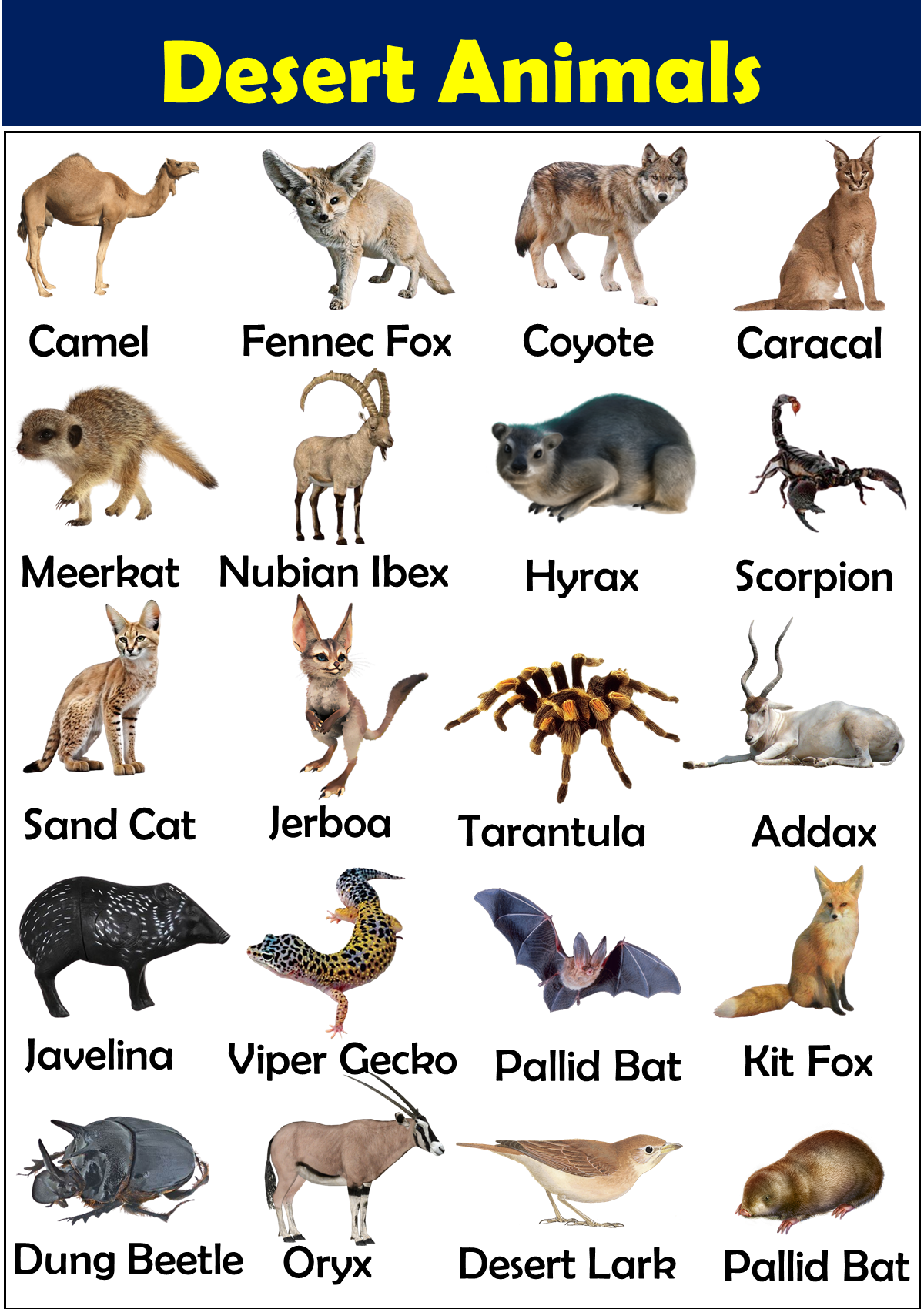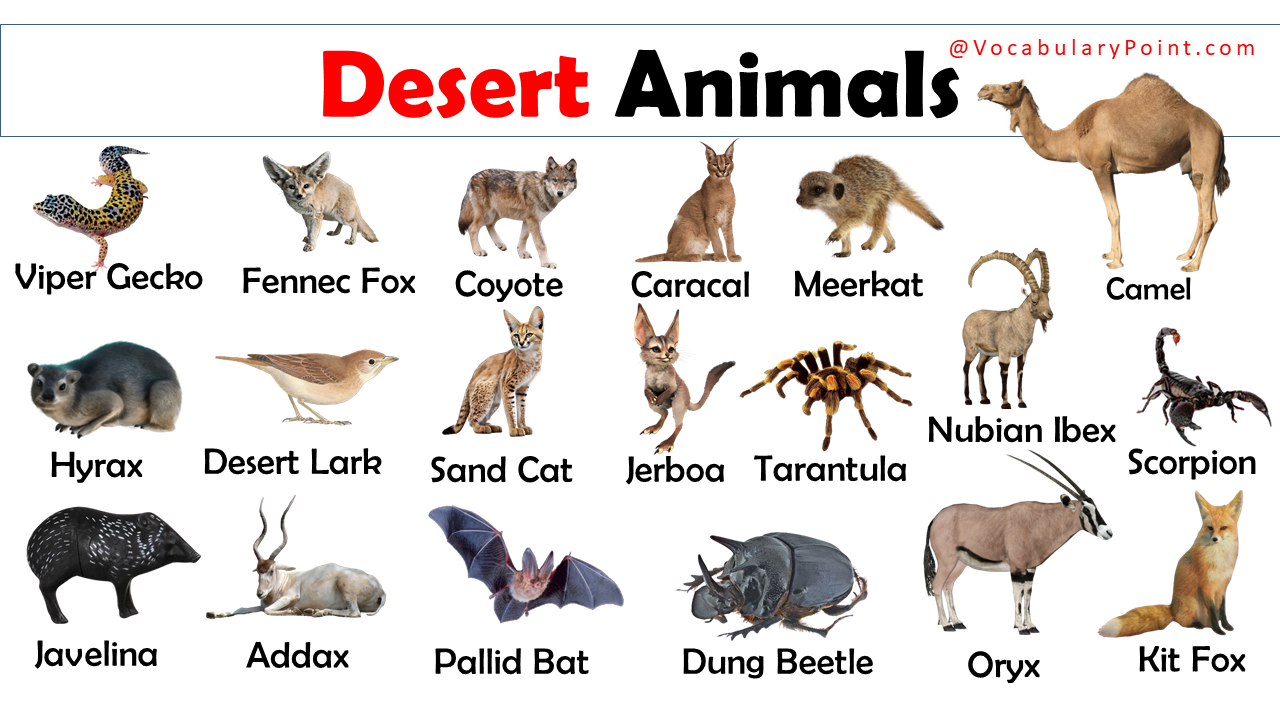Deserts might look empty, but they are full of life! In this blog post, we will explore the incredible animals that survive in the hot and dry desert environment. You’ll learn about how these animals keep cool, what they eat, and how they find water. From clever foxes to tough tortoises, each desert animal has special skills. Get ready to expand your English vocabulary and meet some amazing desert dwellers!
What are Desert Animals?
Desert animals are species that have adapted to the extreme conditions of desert environments. These adaptations might include the ability to conserve water, regulate body temperature, and find food in a habitat where these resources are scarce. Deserts, characterized by their dry conditions, sparse vegetation, and temperature extremes, host a variety of animals that have developed unique survival strategies.
List of Desert Animals
- Camel
- Fennec Fox
- Meerkat
- Coyote
- Rattlesnake
- Roadrunner
- Armadillo
- Desert Tortoise
- Scorpion
- Kangaroo Rat
- Gila Monster
- Antelope Jackrabbit
- Dung Beetle
- Sidewinder Snake
- Oryx
- Sand Cat
- Jerboa
- Puma
- Tarantula
- Desert Bighorn Sheep
- Horned Viper
- Hyrax
- Caracal
- Pronghorn Antelope
- Desert Elephant
- Chuckwalla
- Moloch Lizard
- Addax
- Sahara Desert Ant
- Nubian Ibex
- Desert Monitor
- Arabian Oryx
- Elf Owl
- Kit Fox
- Lappet-faced Vulture
- Desert Lark
- Saguaro Cactus Cricket
- Thorny Devil
- Uromastyx Lizard
- Black Widow Spider
- Javelina
- Arabian Sand Gazelle
- Golden Mole
- Namib Desert Beetle
- Sandfish Skink
- Spotted Hyena
- Agama Lizard
- Red Kangaroo
- African Wild Dog
- Barbary Falcon
- Cape Cobra
- Zebra Tarantula
- Houbara Bustard
- Gemsbok
- Grant’s Golden Mole
- Desert Night Lizard
- Pharaoh Eagle-Owl
- Saharan Silver Ant
- Deathstalker Scorpion
- African Black Beetle
- Long-eared Jerboa
- Soaptree Yucca Moth
- Pallid Bat
- Greater Roadrunner
- Desert Rain Frog
- Sandgrouse
- Leaf-nosed Snake
- Dromedary Camel
- Viper Gecko
- Speckled Pigeon
Explore More Animal Vocab:

Desert Animals Vocabulary and Their Facts
1. Camel
Camels are renowned for their ability to travel long distances across deserts without water. They store fat in their humps, which can be converted into water and energy when sustenance is not available. These resilient animals have thick coats that protect them from desert heat and cold, and they can close their nostrils during sandstorms.
2. Fennec Fox
The fennec fox, characterized by its unusually large ears, uses these to dissipate heat and keep cool in the Sahara Desert. It is the smallest species of canid, its coat, ears, and kidney functions are adapted to high-temperature, low-water environments. They are omnivorous, eating everything from insects to plants.
3. Meerkat
Meerkats are social animals found in the Kalahari Desert. They live in large groups called mobs or gangs, and they have a complex social structure. Known for standing on their rear legs to scan the desert for predators, they primarily eat insects and are immune to certain venoms.
4. Coyote
Coyotes are highly adaptable creatures that can thrive in diverse environments, including deserts. They have a varied diet that can include fruits, insects, and small animals. Coyotes are known for their cunning, often demonstrated by their ability to find food and water in harsh conditions.
5. Rattlesnake
Rattlesnakes are venomous snakes that inhabit American deserts. They can control how much venom to inject with each bite, depending on the threat or prey. They use their distinctive rattle as a warning to predators, vibrating it to produce a hissing sound when threatened.
6. Roadrunner
The roadrunner is a fast-running bird native to the deserts of the southwestern United States. Famous for its speed, it can run up to 20 miles per hour to catch prey or escape predators. Roadrunners are opportunistic feeders, eating everything from insects to small reptiles and birds.
7. Armadillo
Armadillos are known for their tough, armored shells, which provide excellent protection against predators. In desert environments, they dig burrows to stay cool and search for food, which mainly consists of insects and small vertebrates.
8. Desert Tortoise
The desert tortoise is adapted to life in a hot, dry environment. It spends up to 95% of its life in burrows that help regulate its body temperature and reduce water loss. They can live where ground temperatures exceed 140 degrees Fahrenheit by burrowing.
9. Scorpion
Scorpions are arachnids commonly found in desert landscapes. They have a tough exoskeleton, which helps prevent water loss, and they can control their metabolism to survive on very little. Their venomous stings are used both for hunting prey and as a defense against predators.
10. Kangaroo Rat
Kangaroo rats are notable for their ability to survive without ever drinking water. They extract sufficient moisture from their seed-based diet to sustain themselves. Their long hind legs enable them to make remarkable leaps, especially useful for escaping predators.
11. Gila Monster
The Gila monster is one of the few venomous lizards and is native to the southwestern United States. It has a slow metabolism and can eat up to a third of its body weight in one meal, which sustains it for months. It uses its venom to subdue prey, typically small mammals and birds.
12. Antelope Jackrabbit
The antelope jackrabbit, a large North American hare, is well adapted to the arid conditions of the desert. It has oversized ears that radiate heat to help control its body temperature. It is extremely fast and can use bursts of speed to escape predators.
13. Dung Beetle
Dung beetles are crucial to desert ecosystems as they help recycle nutrients by breaking down animal waste. They can bury dung balls several times their size, which they use as a food source and breeding chambers.
14. Sidewinder Snake
Known for its distinctive movement, the sidewinder snake “sidewinds” to move across the hot desert sand while exposing minimal body surface to the ground. This unique form of locomotion also helps it ambush prey, such as lizards and small rodents.
15. Oryx
The oryx is a large antelope with striking horns and a robust build, allowing it to survive in arid conditions. It can detect rainfall and migrate towards it. The oryx conserves water by raising its body temperature to avoid perspiring.
16. Sand Cat
Sand cats are the only cats that live primarily in deserts. They have thick fur on their paws that protects them from hot sands and are proficient hunters of small desert vertebrates. Their wide ears allow them to detect prey moving underground.
17. Jerboa
Jerboas have long hind legs and short forearms, allowing them to jump several feet in the air to evade predators. They are nocturnal and spend the hot daytime hours in burrows to stay cool. Jerboas do not drink water; they obtain enough moisture from their food.
18. Puma
Also known as cougars or mountain lions, pumas inhabit a range of environments including deserts. They are top predators and have a wide diet that helps them adapt to various ecosystems. Pumas are solitary and territorial animals.
19. Tarantula
Tarantulas in desert regions are burrowers that create deep dens which offer protection from heat and predators. They feed primarily on insects, but larger tarantulas can capture small rodents and birds.
20. Desert Bighorn Sheep
Desert bighorn sheep are adapted to mountainous desert areas where they skillfully climb steep slopes to escape from threats. They can go without water for several days, getting moisture from their food.
21. Horned Viper
The horned viper uses its horns to shield its eyes from the sand and is well adapted to the desert environment. It buries itself in the sand to ambush prey, striking with precision and injecting potent venom.
22. Hyrax
While primarily found in rocky areas, the hyrax also inhabits arid desert regions. They have specialized padded feet that grip smooth surfaces, aiding in climbing rocks to evade predators.
23. Caracal
The caracal is a medium-sized wild cat known for its distinctive tufted ears. In desert environments, caracals use their superb hunting skills to catch birds, rodents, and even small antelopes.
24. Pronghorn Antelope
The pronghorn is the second fastest land animal and uses its speed to escape predators in the open desert. It has excellent vision and can detect movement up to 4 miles away, helping it stay alert to danger.
25. Desert Elephant
Desert elephants are not a distinct species but are African elephants adapted to living in Namibia’s desert environments. They travel extensive distances to find water and have smaller bodies and larger feet than other elephants to better navigate sandy deserts.
26. Chuckwalla
Chuckwallas are large lizards that escape predators by inflating their bodies in rock crevices so they cannot be easily removed. They are herbivores and consume leaves, fruit, and flowers which provide them with sufficient hydration.
27. Moloch Lizard
The Moloch lizard, or thorny devil, has a body covered with spikes that help protect it from predators. It collects water by channeling dew via its skin to its mouth, a unique adaptation to its arid habitat.
28. Addax
The addax is a type of antelope that has adapted perfectly to desert life, rarely needing to drink water and getting most of its moisture from food. It has broad, flat hooves that prevent it from sinking into the sand.
29. Sahara Desert Ant
Sahara desert ants are one of the most heat-tolerant terrestrial creatures in the world. They navigate using the sun and can locate their nest without getting lost, even in the featureless desert.
30. Nubian Ibex
The Nubian ibex is a desert-dwelling goat known for its ability to climb steep, rocky terrain. Its hooves have sharp edges and a soft inner portion to grip the rock, and it can detect predators from great distances thanks to its keen eyesight.
